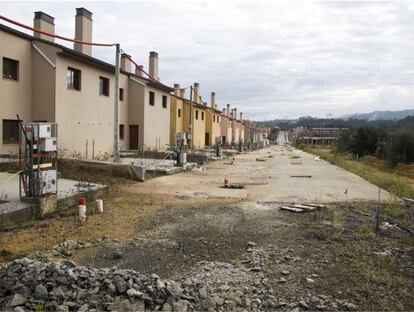Documenting Spain¡¯s construction boom and bust
There are thousands of unfinished or empty properties throughout the country A new database invites the public to share information about them


Between 2000 and 2008, around five million homes were built in Spain, many of them along the country¡¯s extensive Mediterranean coastline, while others were part of vast residential estates constructed on greenfield sites, often in rural or protected areas. Seven years after the country¡¯s property bubble burst, estimates suggest there are at least three million properties standing empty, along with tens of thousands more that are unfinished.
Spain¡¯s independent Sustainability Observatory says that between 1986 and 2006, an average of 44 hectares of land per day was being developed
In the absence of an official census on the impact of the property boom and bust, a number of online citizens¡¯ initiatives have begun documenting the evidence: Ruinas modernas (Modern ruins) focuses on half-completed private?residential estates; Naci¨®n Rotonda (Roundabout Nation) on new road building; Ecologistas en Acci¨®n (Ecologists in Action) on the wider impact on the environment; and Basurama on garbage disposal and landfills.
Last year, the organizers of these projects met at the Arquinset festival in Barcelona, an annual forum to discuss architecture, public spaces, and urban planning. They decided to share the information they have spent years collecting: around 800 cases that include ghost towns, abandoned public buildings, half-finished infrastructure, and vast, deserted industrial estates.
Resuscitate a cadaver
The cad¨¢veresinmobiliarios.org database invites the public to ¡°unearth, adopt, or look after¡± a post-bubble cadaver. Unearthing means locating and notifying the site of the existence of an unfinished construction project. Adopting involves providing more detailed information, and taking care of one means ¡°bringing the victim to intensive care, documenting everything possible: the number of properties, the amount of land involved, who approved the plan, and the construction company involved.¡±
The majority of properties identified so far by the database are in Madrid, along the Mediterranean, and the Canary Islands. Among the worst examples are sprawling developments in the Vallecas district in the south of the capital, where thousands and thousands of square meters of buildings are in different stages of construction, says Pablo Rey of Basurama: "This is land next door to landfill sites that the regional government of Madrid has occupied but not built on."
Not that there is any shortage of blots on the wider landscape, such as a marina built in the middle of a reservoir in C¨¢ceres province in Extremadura, or the so-called City of the Environment, in Soria, a small province in Castilla y Le¨®n: ¡°This pretty much sums up the madness of the construction boom: it¡¯s half-finished, it¡¯s in a natural park, it was protected by the Popular Party regional government there, and it was begun in 2012, when the scale of the disaster was already very clear,¡± says Schultz-Dornburg.
The result, announced at Arquinset¡¯s 2015 edition earlier this month, is a newly created online database called cadaveresinmobiliarios.org, which invites the public to document empty or unfinished property developments.
Julia Schultz-Dornburg has been cataloguing the legacy of Spain¡¯s construction boom for more than a decade, and in 2012 published Ruinas modernas. Una topografia del lucro (or, Modern Ruins, a topography of profit) in which she documents ¡°ruins, interesting places, the spaces between what was and what could have been and that have many layers: architectural, economic, anthropological, sociological, political¡¡± she says, pointing out that these failed projects ¡°are the responsibility of many people, and nobody was able to stop them.¡± Spain¡¯s independent Sustainability Observatory says that between 1986 and 2006, an average of 44 hectares of land per day was being developed.
She explains that the new online database provides different perspectives on the impact of each property development: the environment, land use, image, mobility, health, and the lifestyles of residents.
Naci¨®n Rotonda was set up by three civil engineers and an architect who have used Google Earth to locate unfinished or empty construction projects. ¡°These are infra-neighborhoods, although they are not the fruit of development, but rather of speculation, places with no services, and that are neither town or countryside, and whose inhabitants have to live with the moral burden of being trapped in the worst of two worlds,¡± says Miguel ?lvarez, one of the three.
Basurama¡¯s 6,000 km project explores the ¡°metabolism¡± of Spain¡¯s towns and cities through photographs of ¡°landscapes related to production, consumption and disposal of materials and energy, as well as infrastructure and residential developments,¡± says founder member Pablo Rey, who also invites the public to contribute. ¡°The incredible thing about all this is that despite all the information available, we haven¡¯t learned anything, because the authorities are once again talking about construction as the answer to the country¡¯s economic problems,¡± he says.
¡°Cadaveresinmobiliarios.org will allow us to compare ideas about what has happened. Until now, this is a subject that has been approached purely from an economic angle, in terms of bailouts, debt¡ but these figures have little to do with reality,¡± says ?lvarez. Schultz-Dornburg says she hopes the initiative will raise awareness about what she calls the ¡°magnitude of the tragedy.¡± ¡°There are no official figures, in part because they have been hidden. We need to start a new debate based on this information to decide what we¡¯re going to do about all this.¡±
Tu suscripci¨®n se est¨¢ usando en otro dispositivo
?Quieres a?adir otro usuario a tu suscripci¨®n?
Si contin¨²as leyendo en este dispositivo, no se podr¨¢ leer en el otro.
FlechaTu suscripci¨®n se est¨¢ usando en otro dispositivo y solo puedes acceder a EL PA?S desde un dispositivo a la vez.
Si quieres compartir tu cuenta, cambia tu suscripci¨®n a la modalidad Premium, as¨ª podr¨¢s a?adir otro usuario. Cada uno acceder¨¢ con su propia cuenta de email, lo que os permitir¨¢ personalizar vuestra experiencia en EL PA?S.
?Tienes una suscripci¨®n de empresa? Accede aqu¨ª para contratar m¨¢s cuentas.
En el caso de no saber qui¨¦n est¨¢ usando tu cuenta, te recomendamos cambiar tu contrase?a aqu¨ª.
Si decides continuar compartiendo tu cuenta, este mensaje se mostrar¨¢ en tu dispositivo y en el de la otra persona que est¨¢ usando tu cuenta de forma indefinida, afectando a tu experiencia de lectura. Puedes consultar aqu¨ª los t¨¦rminos y condiciones de la suscripci¨®n digital.








































